Artillery Fungus (Sphaerobolus): This wood decomposer is found in mulched areas and has probably caused the most concern to landscapers and potentially poses some economic concern to their clients. This fungus produces fruiting structures that resemble tiny cream or orange-brown cups that hold a spore mass resembling a tiny black egg (0.1 inches in diameter). When enough water accumulates, the spores are shot high into the air up to several yards. The dark-colored spores resemble small tar spots and will stick to house siding, downspouts, cars, leaf surfaces, and any nearby structure. The artillery fungus is strongly phototrophic & will shoot its spores toward light sources or white-colored surfaces. The spores have extreme adhesive qualities & are difficult to remove, even with high-pressure sprayers.
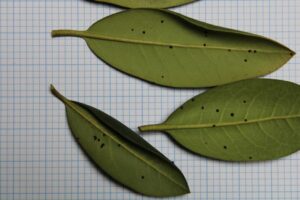
The black colored spores of Artillery Fungus can also be mistaken for pests (e.g., scales) when stuck on the undersides of plant leaves. (Photo Credit: Tim Waller, Rutgers Coop. Ext.)
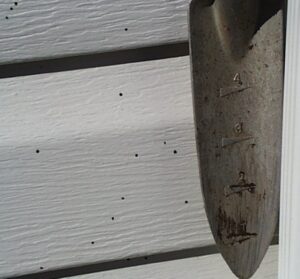
Artillery Fungus black spores can mare the surface of white siding on houses. (Photo Credit: Steven K. Rettke, Rutgers Coop. Ext.)
The Landscape Pest Notes Blog for Late May 2023 reviews a dozen insect & disease pests that are commonly observed during the second half of May within NJ landscapes & nurseries. The insect pests highlighted include the elongate hemlock scale, pine needle scale, Euonymus scale, Taxus mealybug, four-lined plant bug, & aphids. In addition to the artillery fungus, the other fungal organisms included are black sooty mold, Volutella blight, cedar rust diseases, Cytospora canker, & Botrytis.
Elongate Hemlock Scale (Fiorinia externa) (360-700 GDD = 1st generation crawlers): An armored scale found on the underside of hemlock foliage, and sometimes on spruce, Douglas fir, and yew. Female covers are oval, flat, and tan/translucent; males are whitish. There may be six or more scales per needle. Yellow spots appear on needles under light feeding and foliage appears thin; in heavy infestations, needle drop occurs, and trees may be killed. Adult females have an exceptionally long egg-laying period (lasting throughout the summer) with two overlapping generations. Crawlers (immatures) are noticeable in late May, in conjunction with new growth. Although there are only two generations per year, crawlers can emerge over an extended period. Look for the tiny crawlers using a 10-15x hand lens.

Elongate Hemlock Scales showing the white wax produced by males. The females are nearly completely covered by the white waxy filaments. (Photo Credit: Steven K. Rettke, Rutgers Coop. Ext.)
The Elongate hemlock scale is one of the most difficult scale species to control. They produce a puparium-like type of waxy cover, which extends under the body of the insect as well as over the top (i.e., only the sucking mouthpart creates an opening through the wax). Although oil, soap, and other insecticides are labeled, control may be mixed because all life stages are active at any one time. Pyriproxyfen (Distance) is an insect growth regulator & can provide good suppression. It is classified as a “reduced risk” material by the EPA. Acephate (Orthene) has translaminar properties within foliage & can provide some suppression.
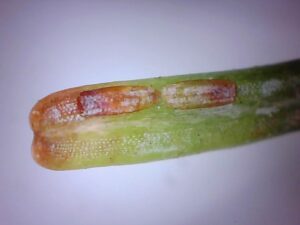
The females of the Elongate Hemlock Scales are now clearly visible when the white wax is removed. (Photo Credit: Steven K. Rettke, Rutgers Coop. Ext.)
Dinotefuran (Safari) is a neonicotinoid that has been a product of choice to control armored scales for more than a decade. Imidacloprid (Merit) is highly effective in controlling the hemlock woolly adelgid but will not provide satisfactory control of elongate hemlock scales. After October of 2023, the neonicotinoids will no longer be labeled for use within NJ residential landscapes.
Pine Needle Scale (Chionaspis pinifoliae) (298-448 GDD = 1st generation crawlers): This armored scale insect is a common pest of pines, especially Scotch pine, mugo pine, Austrian pine, and red pine, and occasionally on white pine, Norway spruce, and Colorado spruce. White elongated shaped adult female covers are 1/8 inch and found only on needles. A long egg-laying/crawler emergence period occurs from late May into mid-June, with a second generation in July (1290-1917 GDD). When the pink crawlers settle, they turn in color to yellowish tan, lose their legs, and never move again.
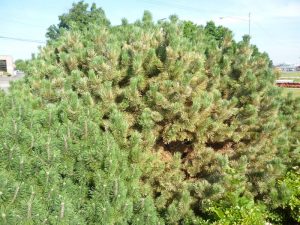
Large mugo pine showing symptoms from an infestation of Pine Needle Scales. (Photo Credit: Steven K. Rettke, Rutgers Coop. Ext.)
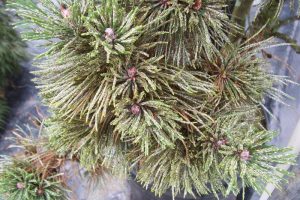
Extreme infestation with many dozens of Pine Needle Scales per individual needle. (Photo Credit: Steven K. Rettke, Rutgers Coop. Ext.)
The crawler stage and early settling periods are the ideal time to control them with insecticidal soap or 2% horticultural oil (i.e., these materials also minimize harm to beneficial insects). Research in Ohio showed that oil provided better control than did Orthene or Sevin. Control with these products will be good up until the time the crawlers begin to show some “white” or protective wax around the edges. To limit the impact on beneficials, avoid broad-spectrum insecticides unless necessary.
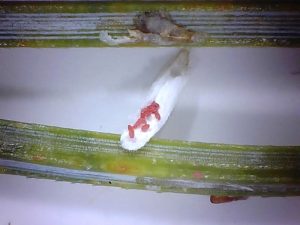
Pine Needle Scales overwinter as bright red eggs beneath wax cover of dead female scale. (Photo Credit: Steven K. Rettke, Rutgers Coop. Ext.)
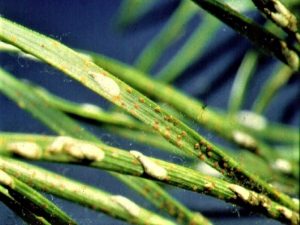
Reddish colored crawlers of Pine Needle Scales emerging out from under female waxy covers. (Photo Credit: Ohio State Coop. Ext.)
Euonymus Scale (Unaspis euonymi) (533-820 GDD 1st generation crawlers): The light-yellow crawlers are active during the early weeks of June or when the Kousa Dogwood is in bloom (i.e., within the more southern counties of NJ, crawlers can become active during the last week of May). Variegated evergreen euonymus plants are especially vulnerable to this scale. This armored scale has sexual dimorphism since the males are white, thin & elongated while the females are dark-brown, oyster-shell shaped & larger. Males feed primarily on leaves & the females will more commonly be found feeding on branches.
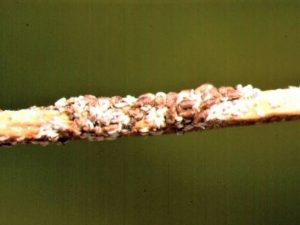
Euonymus Scales have sexual dimorphism with females being dark gray & oyster shell shaped while males are white & narrowly elongated. (Photo Credit: Steven K. Rettke, Rutgers Coop. Ext.)
In the southern counties of NJ, begin checking plants for crawlers during the last week of May (533 GDD = first signs of crawler emergence). Monitor before treating by using double-sided tape or sticky traps. Use a hand lens to see the yellow/orange tiny crawlers. Multiple sprays may be required if using horticultural oil since crawlers hatch over a 2–3-week period. This scale feeds within plant cells & the mostly males feeding on leaves will create distinctive symptoms having off-colored yellow spots. If populations are allowed to build up, then defoliation will result, and the plants will be weakened. With higher infestations, Euonymus scales will frequently kill most species of evergreen Euonymus. There will be a 2nd generation of crawlers emerging in August-September.
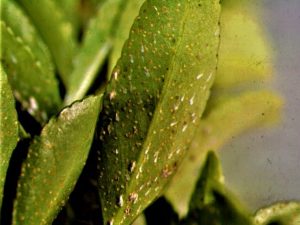
Yellow colored Euonymus Scale crawlers emerging. These crawlers moved to leaves from branch stems where the female mostly feed. (Photo Credit: Steven K. Rettke, Rutgers Coop. Ext.)
Most armored scale species with broadleaf hosts will feed either on bark or leaf tissues, but usually not both (Euonymus scales are a notable exception). The crawlers have only 24 to 48 hours after hatching before they must insert their mouthparts into plant cells and begin feeding. Once armored scale crawlers settle, they do not move again for the remainder of their lives (winged adult male scales do change positions but cannot feed and only live for 24 hours).
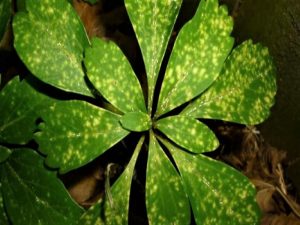
Feeding symptoms from male Euonymus Scales feeding on pachysandra leaves. (Photo Credit: Steven K. Rettke, Rutgers Coop. Ext.)
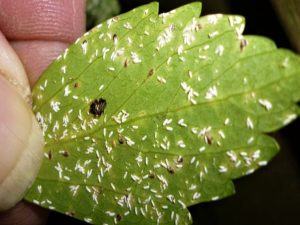
On the undersides of the pachysandra leaf, signs from mostly male & a few female Euonymus Scales are found feeding. (Photo Credit: Steven K. Rettke, Rutgers Coop. Ext.)
A horticultural oil plus Orthene combination has been shown to provide good control management after crawlers settle (before they turn white/gray). The Orthene will suppress the white males feeding on the leaves, while the oil reduces the brown females present on the stems. The systemic insecticide Safari (dinotefuran) can also be successful. The reduced-risk neonicotinoid, TriStar (acetamiprid) will also provide results against this scale insect. After October of 2023, the neonicotinoids will no longer be labeled for use within NJ residential landscapes. Euonymus kiautschovica has resistance against the Euonymus scale & should be used as a replacement where possible.
Taxus Mealybug (Dysmicoccus wistariae) =(246-618 GDD = adults/crawlers): Some may find it surprising that mealybugs are categorized as a family of scale insects. Although yews have relatively few insect problems, this pest is sometimes found in significant numbers. They are present now in the branch forks and nodes. The adults are covered with white cottony wax. They produce honeydew, so look for the shiny sticky substance on the leaves and for the black sooty mold that will grow on the honeydew. The feeding will cause yellowing and dieback of branches. Stunting of younger plants can occur with high infestations.
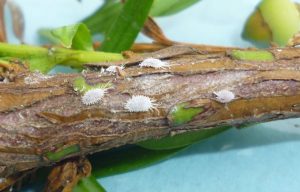
Taxus Mealybug body has 15 to 17 pairs of waxy tuffs with the last pair about one-fourth the length of the body. (Photo Credit: Steven K. Rettke, Rutgers Coop. Ext.)
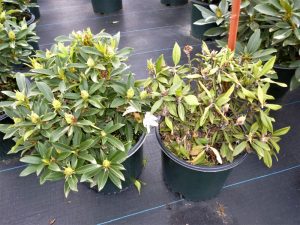
The Taxus Mealybug infested plant on right shows obvious stunting & discolored symptoms. (Photo Credit: Steven K. Rettke, Rutgers Coop. Ext.)
Mealybugs are generally recognized as among some of the more difficult-to-control insects in the landscape. Their waxy covering can be difficult to penetrate. Monitor for the presence of beneficials. If a large population of beneficials is present, then attempt to preserve them by spraying them with horticultural oil or insecticidal soap. Orthene and some of the pyrethroids are examples of other labeled insecticides. Unexpectedly, neonicotinoids may not provide satisfactory efficacy.
Four-Lined Plant Bug (Poecilocapsus lineatus) =(mid-spring weeks): The four-lined plant bug is a true bug with piecing-sucking mouthparts. Primary woody ornamental host plants include rose, dogwood, Azalea, Viburnum, and Forsythia (e.g., sentinel plant). Other hosts also include many herbaceous plants with snapdragon, mint, mums & black-eyed-Susan being common favorites.
This insect creates necrotic spots that can mimic the appearance of fungal leaf spots. While feeding, the nymph or adult insect will introduce toxic substances through their salivary ducts. Within less than a minute, the leaf tissues will turn black at the feeding location where the toxin is inserted. A few days later the feeding spots will develop a brown discoloration as the plant cells die & the leaf tissue becomes necrotic.
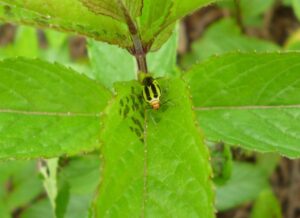
Four-Lined Plant Bug adult feeds on leaf & injects a toxin with its’ piercing-sucking mouthpart. (Photo Credit: Steven K. Rettke, Rutgers Coop. Ext.)
A diagnostic curveball results when the necrotic tissue areas dry up & crumble away to create holes in the leaves. Consequently, caterpillars, leaf miners, or shot-hole fungal leaf spots can often incorrectly be determined to be the cause of plant injuries. Typically, does not require a large population of four-lined plant bugs to cause a significant amount of injury to host plant leaves. However, for woody ornamentals, this pest rarely causes any significant plant healthcare concern & often only produces curiosity.
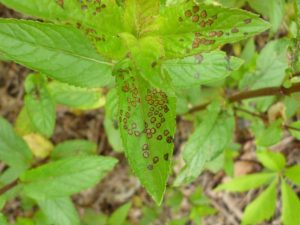
Numerous dark colored feeding spots indicates where the Four-Lined Plant Bug has been feeding. (Photo Credit: Steven K. Rettke, Rutgers Coop. Ext.)
The four-lined plant bug has only one generation per year. It overwinters as eggs that are inserted into one-year-old woody stems. Usually, the eggs hatch sometime during May in most parts of NJ (i.e., there does not appear to be any universally accepted GDD for this pest) & active stages may extend for only three or four weeks.
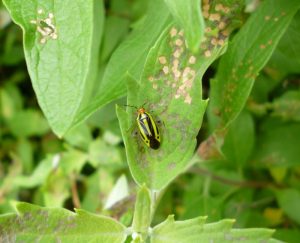
Within a few days the feeding sites become necrotic as plant cells dry. Eventually these dead tissues dry-up & can crumble away. (Photo Credit: Steven K. Rettke, Rutgers Coop. Ext.)
Horticultural oil or insecticidal soap sprays can provide effective controls against immature nymphs. Most contact insecticides can also be effective, although since this insect primarily feeds on leaf undersides, proper coverage may be difficult. Materials having systemic or translaminar properties work best. The reduced-risk product acetamiprid is labeled for use against plant bugs.
Aphid species (Aphididae) / Beneficials =(spring weeks): Within the landscape, the numerous aphid species probably receive too much attention and should more realistically be classified as “junior-varsity pests.” Many of the aphid species that are present this spring on the new growth of certain plants (e.g., burning bush, rose, and spirea), will eventually migrate to feed on alternate hosts (often weeds) during the summer.
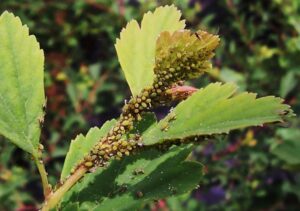
Aphids are often plentiful during the early spring plant growth. (Photo Credit: Steven K. Rettke, Rutgers Coop. Ext.)
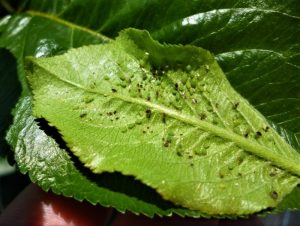
Stealthy aphids can often be found feeding on leaf undersides. (Photo Credit: Steven K. Rettke, Rutgers Coop. Ext.)
Furthermore, lady beetle, green lacewing & hover, fly predators, are becoming active & will be feeding on soft-bodied insect pests (e.g., aphids, scale crawlers, mites). Look carefully among aphid populations to find either the larvae or adults of predators somewhere on the plant. If there are sizable predator populations or if aphids are not significantly harming the plant, consider not spraying. Continue to monitor and knock down the aphid population with horticultural oil if aphids are outproducing the predators. Insecticidal soaps will only give suppression at best.
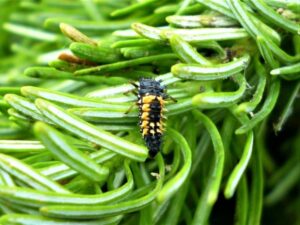
Lady Bird Beetle Larva species that specializes feeding on aphids. (Photo Credit: Steven K. Rettke, Rutgers Coop. Ext.)
Parasitoid wasps have also started becoming active & their presence can be detected by the circular exit holes on the swelled grey-colored dead aphid bodies. Emerging adult parasitoid wasps create these holes. Healthy leaves produced later in the season after aphid populations wane will hide any leaves damaged now.
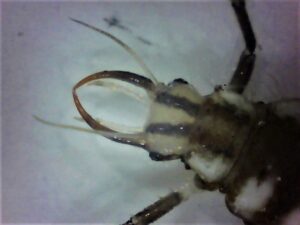
Close-up of the deadly fangs of the Lacewing Larva. They can easily puncture the soft body of aphids & rapidly suck out body fluids . (Photo Credit: Steven K. Rettke, Rutgers Coop. Ext.)
However, many shade trees (e.g., maples, oaks, lindens, birches, tulip poplars, etc.) will continue to have populations of aphids during the mid-weeks of summer. When encountered, first consider if the pest is presenting an aesthetic problem. Maybe the various beneficials are too slow to build up & the client is upset or inconvenienced by the presence of honeydew or sooty mold. Is the honeydew/sooty mold an eyesore on the tree or is it a nuisance, appearing on objects under the tree such as cars, patio furniture, decks, or sidewalks? Aphids rarely threaten the health of the tree, particularly later during the season. Predators often maintain the population within acceptable levels if left alone.
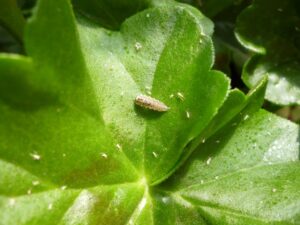
Flower Fly Larvae (Syrphid flies) often go unrecognized in the landscape. These maggots are excellent aphid predators. (Photo Credit: Steven K. Rettke, Rutgers Coop. Ext.)
Foliar predators of aphids, such as ladybeetles, green lacewings, and flower flies, cause aphids to drop off plants as a self-defense mechanism. Almost 25 years ago, researchers in Wisconsin showed that up to 60% of aphids will tuck their legs and drop to the ground within 1 hour of exposure to ladybeetles. Meanwhile, there are ground predators of aphids just waiting for a snack, including carabid ground beetles, spiders, ants, and tiger beetles. This combination effect of predators in different habitats is synergistic. Without the foliar predators causing aphids to drop, the ground predators ate few aphids. Alternatively, when foliar predators were present, ground predators ate many aphids. An experiment on caging predators and aphids showed 50% control of aphids with only ground predators, 75% control with only foliar predators, and almost 100% control with both.
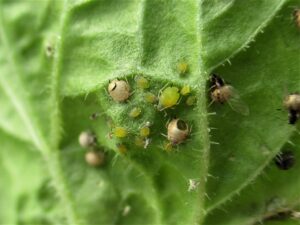
A close look at the parasitised mellon aphids with a clear view of the smooth edged exit holes the adult parasitoid wasps were required to make to escape from the carcasses of the dead aphids. (Photo Credit: Steven K. Rettke, Rutgers Coop. Ext.)
Honeydew & Black Sooty Mold Fungus: Most landscapers are familiar with the honeydew created by the feeding from aphids, soft & felt scales, plant bugs, whiteflies, and mealybugs and the associated black sooty mold that follows soon afterward. Sooty mold is not a plant pathogen, but it can block sunlight & reduce the photosynthetic abilities of the leaves. Smaller ornamental plants can potentially be killed in more extreme occurrences.
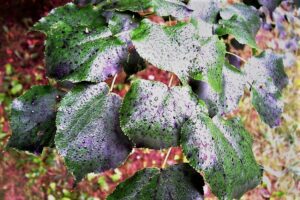
An extreme build-up of Black Sooty Mold fungus on aphid infested linden tree leaves. (Photo Credit: Steven K. Rettke, Rutgers Coop. Ext.)
Incompletely digested plant fluids (honeydew) are shiny, sticky, and loaded with sugary carbohydrates. This food source becomes an irresistible attractant to an assortment of ants, bees, and other stinging and biting insects. When the infestations are light and sprays are required, apply horticultural oils or insecticidal soaps. In heavy infestations, spray a residual insecticide. To help dislodge the honeydew and sooty mold, add (1%) soap or oil to the tank.
Volutella Blight (Pseudonectria pachysandricola): This fungus often infects pachysandra plants already wounded from winter damage or sunburned leaf tips. Once it has a foothold within these injured areas, the fungus is capable of spreading into healthy tissue. Euonymus scale insect infestations will also predispose infections by this fungus. Affected leaves have obvious brown, circular lesions with concentric bands & will turn yellow & fall from stems. Examine stems to observe for long brown or black colored cankers. When stems are moist they may have pinkish-colored fungal spore masses visible under magnification. Within deeply shaded areas, this disease can often spread throughout entire beds.
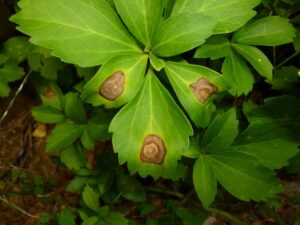
Volutella Blight on pachysandra leaves showing brown spots with concentric rings. (Photo Credit: Steven K. Rettke, Rutgers Coop. Ext.)
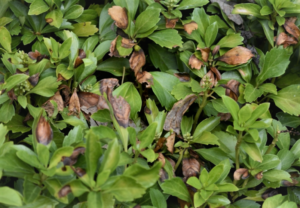
Pachysandra bed planting showing more extensive Volutella Blight infections. (Photo Credit: Richard Buckley, Rutgers Plant Diagnostic Lab)
Thin plant stands periodically to prevent dense growth. Discard & destroy infected foliage & diseased plants. Remove excess leaf litter (vacuum the beds?) & increase plant vigor through fertilization & irrigation, but prolonged periods of leaf wetness will enhance fungus development. Avoid mechanical injuries to reduce future infections. Apply applications of chlorothalonil, copper, mancozeb, myclobutanil, or thiophanate-methyl at the first sign of disease and repeat at label specified intervals and rates. Repeat three times at 10-day intervals & add a spreader-sticker to enhance spray coverage.
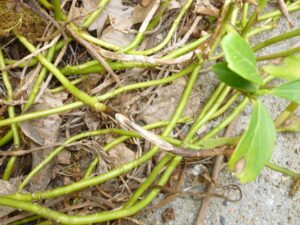
Volutella Blight stem canker on pachysandra. These cankers can kill plants. (Photo Credit: Steven K. Rettke, Rutgers Coop. Ext.)
Cedar Rust Fungi (Gymnosporangium): A group of related fungi called Gymnosporangium affect junipers & several broadleaf trees. Common within the landscape, there are three separate cedar-rust diseases: 1-cedar-apple rust, 2-cedar-hawthorn rust, & 3-cedar-quince rust. The primary differences between these three fungal diseases are the broadleaf hosts that they attack. These fungi attack the juniper host during the summer season & attack the broadleaf host during the spring. Both host trees must be nearby for the disease to complete its life history.
The host trees involved with the cedar-apple rust include the juniper (i.e., especially the eastern red cedar) & apple or crabapple. The cedar-apple rust fungus is not as severe on the juniper as the other two rust diseases. The spore galls that form on the infected juniper require two years to mature. After the second year, the galls can reach the size of a golf ball, but many are also smaller. During wet spring periods, the second-year galls form long, orange-colored, gelatinous horns & release millions of spores. Following spore release, the galls die & are no longer active.
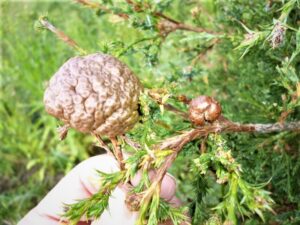
Cedar-Apple Rust Galls require nearly 2 years of growth before mature golf-ball sized galls can release spores. (Photo Credit: Steven K. Rettke, Rutgers Coop. Ext.)
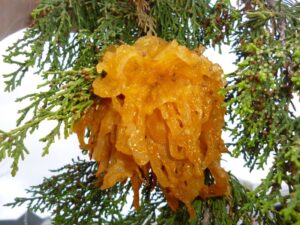
Gelatinous horn-like protrusions emerge from mature 2 year old Cedar-Apple Rust Galls. During wet spring weather, the released teliospores will be carried by the wind to infect broadleaf hosts. (Photo Credit: Steven K. Rettke, Rutgers Coop. Ext.)
On the other hand, the galls that form on the junipers from infection by either the cedar-hawthorn rust or cedar-quince rust diseases are less conspicuous but are more damaging to the evergreen host. During wet periods of the spring, instead of forming the large spore horns, the galls of the cedar-hawthorn rust & cedar-quince rust diseases will form a small, orange gelatinous mass on the surface of the branch as the spores are released. Also, instead of dying after the second year, these galls will remain viable year after year & will grow slightly larger after each season. After several years, the galls can begin to girdle the areas infected & may cause major branch dieback. The spores of cedar-hawthorn & cedar-quince rusts infect a wider variety of broadleaf hosts than cedar-apple rust. They also infect the leaves of apple & crabapple trees but in addition, infect hawthorn, quince, serviceberry & a few others. Therefore, with a larger number of potential hosts, there is a greater chance for both of these rust diseases to complete their life history.
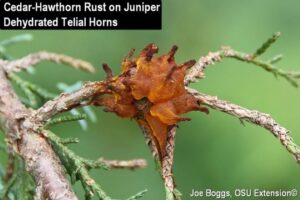
Cedar-Hawthorn Rust Galls are smaller & less obvious on junipers. (Photo Credit: Joe Boggs, Ohio State Coop. Ext.)
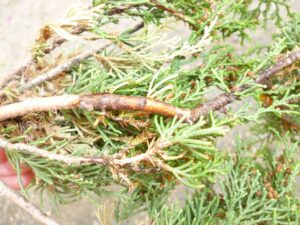
Cedar-Quince Rust Galls on junipers are almost inconspicuous. However, they can be the most damaging to the infected juniper hosts. (Photo Credit: Steven K. Rettke, Rutgers Coop. Ext.)
Signs & symptoms of the rust diseases generally do not show up on infected broadleaf hosts until June or July. Evidence of infection will be found on leaves, fruit, or woody twigs. The leaf spots on the foliage are easy to observe since they all have orange (or rust) discoloration. Rust diseases are the only landscape leaf spots that produce distinctive orange color spots.
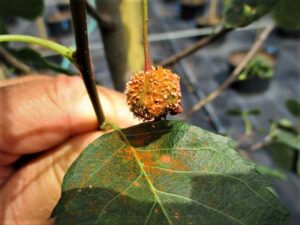
Cedar-Quince Rust on fruit of serviceberry broadleaf host. The orange color is considered to be diagnostic for rust ID in the landscape. (Photo Credit: Steven K. Rettke, Rutgers Coop. Ext.)
Control of cedar-apple rust on juniper should rarely be necessary. Galls can be pruned out. Junipers that have severe cedar-hawthorn rust or cedar-quince rust infections can be treated with mancozeb, and triadimefon (Bayleton 25 T&O) in early July & again at intervals specified on the label.
(Reference: Scouting & Controlling Woody Ornamental Diseases in Landscapes & Nurseries; Gary W. Moorman, Penn State University)
Cytospora Canker of Spruce: This fungus canker is the most destructive disease of Colorado blue & Norway spruce trees in New Jersey. Cytospora canker rarely affects young, vigorously growing trees. The disease is much more likely to occur on trees at least 10 to 15 years old or on trees weakened by environmental stress (i.e., especially drought stress). Although infection by this disease is rarely fatal, the fungus produces cankers that kill branches & seriously disfigure trees. The canker causes a collapse of the branch vascular tissues resulting in sunken, cracked & discolored diamond-shaped lesions on the branches. Cytospora canker first kills the branches closest to the ground, but the disease eventually spreads to all but the uppermost limbs. This infection produces copious quantities of resin which drips to lower branches. The resin eventually hardens & turns crusty & white.
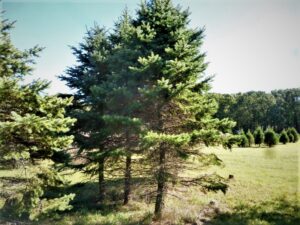
Cytospora Canker on blue & Norway spruces. Infected branches will proceed up the tree as rain splashes the disease spores to other adjacent branches. (Photo Credit: Steven K. Rettke, Rutgers Coop. Ext.)
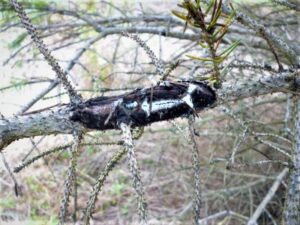
Cytospora Cankers initially form within wounds on lower spruce branches. Cankers can girdle & kill larger stems after several years. (Photo Credit: Steven K. Rettke, Rutgers Coop. Ext.)
Fungicides are ineffective against this disease & are therefore not recommended. Avoid planting in drought prone sites. Branches with symptoms of Cytospora canker should be promptly pruned during dry weather at least 6 to 8 inches below affected tissue. To prevent the spread of this disease on pruning tools, surface-sterilize them between cuts with alcohol.
Botrytis: This grey mold disease is commonly observed in bedding plants. The fungus attacks a vast range of plant hosts, causing cankers, shriveled foliage, &/or leaf spots that kill the tissue. This is often followed by the production of copious brown/grey spores. This disease is common in greenhouses & may be brought into the landscape by infected plant material, particularly on bedding plants.
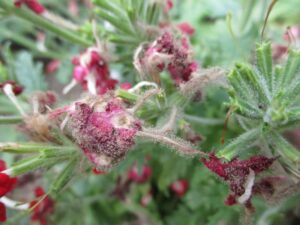
Botrytis infections & spores will often occur on wounded tissues or on flowers & leaves experiencing senescence. This disease thrives under high humidity conditions. (Photo Credit: Steven K. Rettke, Rutgers Coop. Ext.)
Botrytis can attack healthy or wounded tissue. It commonly attacks when infected flowers or leaves fall onto a healthy wet leaf, directly infecting the leaf. Infection always occurs under conditions of high humidity or wetness, & the fungus will also continue to attack under these conditions. Plants can be killed, or significant dieback/distortion can occur. Botrytis usually attacks older tissues (senescence) or young tissues (such as bedding plants), & rarely between these two extremes. Infection can occur within 8 hours, so epidemics can occur rapidly. Within the landscape, fungicide treatments are rarely justified. Simply handpick infected leaves & dispose of them. Within greenhouse environments, fungicide controls will often be necessary.

